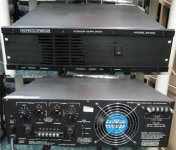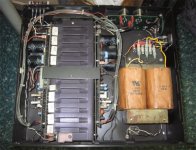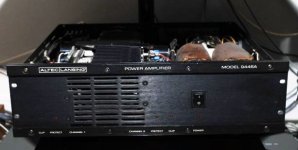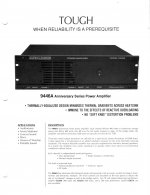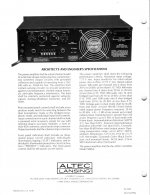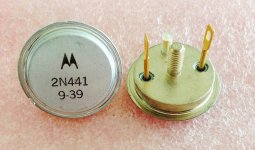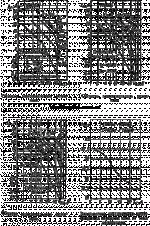That's nothing, the company I work for threw out EVERYTHING, and closed the library.
Over 500,000 items, all related to electrical engineering.
Over 500,000 items, all related to electrical engineering.
Heathkit TA-16 Guitar Amp supplement to post #95 and #96
The guitar amp TA16 from few yoears later uses the same power amp topology (OTL and complementary push pull) and the same output power devices, only mounted on the amp chassis.
VINTAGE c. 1968 Heathkit TA-16 Guitar Amp Twin 12” -- fat sound! (South Park Slope) $150 | www.socialwonder.com
The guitar amp TA16 from few yoears later uses the same power amp topology (OTL and complementary push pull) and the same output power devices, only mounted on the amp chassis.
VINTAGE c. 1968 Heathkit TA-16 Guitar Amp Twin 12” -- fat sound! (South Park Slope) $150 | www.socialwonder.com
Attachments
-
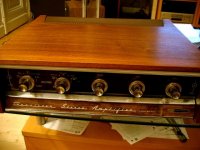 Heathkit AA210-AJ430 front.jpg84 KB · Views: 872
Heathkit AA210-AJ430 front.jpg84 KB · Views: 872 -
 Heathkit TA-16 front.jpg43.3 KB · Views: 838
Heathkit TA-16 front.jpg43.3 KB · Views: 838 -
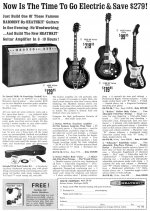 Heathkit TA-16 + Guitars advert 1967.jpg219.1 KB · Views: 812
Heathkit TA-16 + Guitars advert 1967.jpg219.1 KB · Views: 812 -
 Heathkit TA-16 + Guitars advert 1968.jpg190.7 KB · Views: 818
Heathkit TA-16 + Guitars advert 1968.jpg190.7 KB · Views: 818 -
Heathkit TA-16 amp module front & inside.pdf137.4 KB · Views: 1,428
-
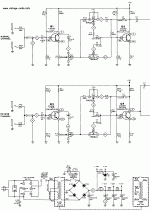 Heatkit Guitar amp schema TA-16.gif149.7 KB · Views: 854
Heatkit Guitar amp schema TA-16.gif149.7 KB · Views: 854 -
 Heatkit Guitar amp schema TA-16-II.gif173.8 KB · Views: 489
Heatkit Guitar amp schema TA-16-II.gif173.8 KB · Views: 489
Last edited:
Altec 9446A - maybe first true complementary "Grounded Collector" Topology
QSC and Harrison create similar amps with follow goal: To avoid stuff for electrical isolated mounting of the power devices.
QSC (model No 1080, 3200, EX4000B) used also grounded collector topology
http://www.qscaudio.com/support/technical_support/schems1.htm
Harrison use the grounded source topology (Source-Connection instead that one from Drain is on the iron TO-3 enclosure by the used Hitachi lateral MOSFET's). This schematic you will find about
http://www.diyaudio.com/forums/solid-state/147392-harrison-type-k4000-k-4000-mkii-2x1000w-4ohm.html
Altec 9446A could be the first power amplifier in this topology
QSC and Harrison create similar amps with follow goal: To avoid stuff for electrical isolated mounting of the power devices.
QSC (model No 1080, 3200, EX4000B) used also grounded collector topology
http://www.qscaudio.com/support/technical_support/schems1.htm
Harrison use the grounded source topology (Source-Connection instead that one from Drain is on the iron TO-3 enclosure by the used Hitachi lateral MOSFET's). This schematic you will find about
http://www.diyaudio.com/forums/solid-state/147392-harrison-type-k4000-k-4000-mkii-2x1000w-4ohm.html
Altec 9446A could be the first power amplifier in this topology
Attachments
Last edited:
Can someone supply me with the schematics for the Marantz 15 and possibly 14?I don't understand the function of the diodes in series with the outputs on the Marantz 14 and 15, could you help here?
supplement to post #85:
Totale restauratie van een JBL SA-600 versterker uit 1966
JBL SA-600 spareparts
Udgangs transister til Jbl sa 600 (post#8 - #14)
Totale restauratie van een JBL SA-600 versterker uit 1966
JBL SA-600 spareparts
Udgangs transister til Jbl sa 600 (post#8 - #14)
If I were a technician, I might have made $3.00/hr at the time. If you want to say 1/2 days pay, then do it, but I made $7500/ year professionally employed at Friden in 1966, and I considered myself relatively well off, compared to most. I had previously been making $2.00/hr working as a part time repair tech at Berkeley Custom Electronics, while finishing college, in early 1966. The dollar at the time was worth 4/1 to the Swiss Frank, German mark, etc. And in 1965, my sister and I got a student discount bed and breakfast in Edinborugh, Scotland for 1 lb/night. If your dad made $10/hr, he made more than a seasoned electronic engineer.
1lb. in anything particular? Pork, beef potatoes?
I knew I had seen his car in Scotland
John Curl was over in Scotland recently.
I saw his Porsche reg. no. JC 23 being driven along the street.
For documentary purposes, the attached pictures indicate what was the status in October 1960, from a AES paper by Jones from GEC.
It is about the 2N656A NPN 60 Volt silicon power transistor, good for several amperes. As you can see, the application is the RCA H.C. Lin inverting audio power amplifier arrangement from 1956, with a bootstrap in the VAS.
Actually, the title about "silicon transistors" is somewhat misleading because TR3 (PNP driver) is a germanium transistor 2N1057. Now you know why Jones prohibed the word "complementary" in his presentation ! The driver stage is completely turning back from complementarity, with TR2 being a silicon NPN power transistor (2N656A selected for minimum beta equal to 20 at 1mA collector current) and TR3 a germanium PNP medium power transistor (2N1057). Amazing !
What was the status regarding germanium transistors, at the same time ? Were there germanium complementary power transistors available yet ? Which ones ?
If somebody could post or point the original paper from RCA written by H.C. Lin in 1956, that will be quite interesting. I guess that the 1956 version is using germanium transistors. Possibly germanium complementary devices ?
Regards,
Steph
Looks like Meyer derived his M/M/M musical instrument amp from this design, published in April of 1968. I remembered that it used the odd prefixed MM transistors from when I first read the article:
http://www.swtpc.com/mholley/PopularElectronics/Apr1968/PE_Apr_1968_pg43.jpg
http://www.swtpc.com/mholley/PopularElectronics/Apr1968/PE_Apr_1968_pg44.jpg
I used AD161/162 at Philips in 1964. But they were medium power by today's standard.
The first high-power transistor in 1965 we got was the OC26 or 29 in a TO3 case. Don't remember if it was N or P. Must have been P Germanium.
jd
Remember the TO-36 package? I tried to build voltage regulators with them when I was a
very young kid, they did not work for long. The ones I had didn't look as nice as these:
Attachments
Interesting discussion.
Take a look at the link below:-
http://users.ece.gatech.edu/~mleach/papers/tcir/tcir.pdf
I guess there are a few improvements we've made since 1966 but, what I find interesting in the circuit is the use of degeneration on the input LTP. Clearly Bart Locanthi new a thing or two about signal dynamics and feedback.
However, for me his 'T' absolutely rocks.
Anyone know what the standard part numbers for the TO-5 and TO-66 pre-drivers and
drivers would have been in the Locanthi T output stage?
I dunno about stirring an 8 year old thread on a 60 year old topic.
The book Transistors I, RCA Laboratories, 1956, has experimental complementary audio amps. The Stanley and Scott paper cites Sziklai 1953 then gives design considerations and measurements on several complementary loudspeaker amplifiers at 0.2W and 2W. It is clear they built and tested them, but no device numbers. Two other papers discuss fabrication of NPN (Germanium) Power devices. The Aronson paper has actual pictures of builds including a 6W comp amp, but 3 of the 4 power devices are "experimental" types (others are good old 2N109).
Bootstrapping is a perfectly valid driver load. In 1970 it was cheaper. (Cheaper yet if you bootstrapped from the speaker.) It will, as Mr Pass says, swing past the rail, which in car-audio makes the difference between 17W and 22W for 4r BTL @ 14.4V supply. It declined because transistors got cheaper than capacitors, and in the relentless search for "better numbers".
There is little wrong with Quasi-Comp. I think even Self admits it does not suck? As the 1967 paper puts it, the big devices are "slaves", largely dominated by the smaller device in front of them.
And as you say, a too-too-symmetrical plan may be "un-natural on the ear".
Be careful about "2N3055". The 1962 version by RCA was a thick slab baked overnight in graphite boats and pried apart. Gain was low and variable, it was slow-ish (faster than big Germanium), but it was quite rugged in ways the specifiers did not understand. In practice it was likely to run out of gain before it went over-current. There was no go-to driver for 2N3055 so the drive was often marginal. They survived large powers.
However planar devices improved. Better gain and speed. Eventually large quantities thus low price. The 2N3055 fabrication was always more art and luck than science. In the 1970s(?) Motorola picked a large planar device which had "similar specs to 2N3055" and started selling it as MJ3055. In low-abuse applications it did well, sometimes "better" than a real baked-biscuit '3055. And being a standard part there was a good-match PNP in the same product line, which cleverly became MJ2955.
2N3055/MJ2955 (when it appeared) was an obvious pairing for toss-together work. You have very few 2N3055/MJ2955 amps because most audio folks 1) felt '3055 was old-hat, and wanted something sexier; 2) doubted the '2955 was a good complement; 3) suspected or learned that the "new '3055" and its '2955 bedmate were not as robust as the old 2N3055; 4) commercial designers could talk to reps and get a just-right part-number a penny cheaper in bulk.
As you say, there were a few costly complements like 3791-2 and MJ802/MJ4502 but the killer product line for generic work WAS the TIP series. When they came out I immediately ordered several samples. I recall $7 for a large NPN and $9 for a large PNP, which I thought was good price. This was a half-day's work for a young man.
The stage in the middle had no special name that I knew. The "VAS" term seems to come along later, well explained in Self's writings.
Yes, Meyer was a pioneer and being one guy alone he had to publish loud and proud to sell kits and pay his rent. Heathkit also knew that having the latest/greatest designs was key marketing. Peavey was also attracted to transistor power and hired Sondermeyer from RCA to get stage-worthy amps.
The Fisher 505-series, many variants, was known to me because I could buy the factory reject boards/sinks and try to repair them. Over the the years Fisher introduced about every new idea: no output cap, Darlingtons, complements, Zener diodes, JFET current-diodes, current-source loading, matched input pair, eventually(!!) current and V-I limiting.
The book Transistors I, RCA Laboratories, 1956, has experimental complementary audio amps. The Stanley and Scott paper cites Sziklai 1953 then gives design considerations and measurements on several complementary loudspeaker amplifiers at 0.2W and 2W. It is clear they built and tested them, but no device numbers. Two other papers discuss fabrication of NPN (Germanium) Power devices. The Aronson paper has actual pictures of builds including a 6W comp amp, but 3 of the 4 power devices are "experimental" types (others are good old 2N109).
Bootstrapping is a perfectly valid driver load. In 1970 it was cheaper. (Cheaper yet if you bootstrapped from the speaker.) It will, as Mr Pass says, swing past the rail, which in car-audio makes the difference between 17W and 22W for 4r BTL @ 14.4V supply. It declined because transistors got cheaper than capacitors, and in the relentless search for "better numbers".
There is little wrong with Quasi-Comp. I think even Self admits it does not suck? As the 1967 paper puts it, the big devices are "slaves", largely dominated by the smaller device in front of them.
And as you say, a too-too-symmetrical plan may be "un-natural on the ear".
Be careful about "2N3055". The 1962 version by RCA was a thick slab baked overnight in graphite boats and pried apart. Gain was low and variable, it was slow-ish (faster than big Germanium), but it was quite rugged in ways the specifiers did not understand. In practice it was likely to run out of gain before it went over-current. There was no go-to driver for 2N3055 so the drive was often marginal. They survived large powers.
However planar devices improved. Better gain and speed. Eventually large quantities thus low price. The 2N3055 fabrication was always more art and luck than science. In the 1970s(?) Motorola picked a large planar device which had "similar specs to 2N3055" and started selling it as MJ3055. In low-abuse applications it did well, sometimes "better" than a real baked-biscuit '3055. And being a standard part there was a good-match PNP in the same product line, which cleverly became MJ2955.
2N3055/MJ2955 (when it appeared) was an obvious pairing for toss-together work. You have very few 2N3055/MJ2955 amps because most audio folks 1) felt '3055 was old-hat, and wanted something sexier; 2) doubted the '2955 was a good complement; 3) suspected or learned that the "new '3055" and its '2955 bedmate were not as robust as the old 2N3055; 4) commercial designers could talk to reps and get a just-right part-number a penny cheaper in bulk.
As you say, there were a few costly complements like 3791-2 and MJ802/MJ4502 but the killer product line for generic work WAS the TIP series. When they came out I immediately ordered several samples. I recall $7 for a large NPN and $9 for a large PNP, which I thought was good price. This was a half-day's work for a young man.
The stage in the middle had no special name that I knew. The "VAS" term seems to come along later, well explained in Self's writings.
Yes, Meyer was a pioneer and being one guy alone he had to publish loud and proud to sell kits and pay his rent. Heathkit also knew that having the latest/greatest designs was key marketing. Peavey was also attracted to transistor power and hired Sondermeyer from RCA to get stage-worthy amps.
The Fisher 505-series, many variants, was known to me because I could buy the factory reject boards/sinks and try to repair them. Over the the years Fisher introduced about every new idea: no output cap, Darlingtons, complements, Zener diodes, JFET current-diodes, current-source loading, matched input pair, eventually(!!) current and V-I limiting.
11 years ago I made a bench PSU using 2x ADZ16 in parallel, with a russian P201E to form a Darlington, controlled by a LM723CH (metal can... more nice), including a aggressive foldback I-V limiting (perhaps more aggressive than some ICs) and plenty of frequency compensation for the turtle fT transistor. 22V input and adjustable from 2 to 18V. 11A with 13-14V output (input sagging), but less than 3 or 4A with 6V out, for example. Fan included. Never had a single device failure, but the fan is king here, and with too much heat (fan failure) the leakage starts to mess the output voltage when unloaded.Remember the TO-36 package? I tried to build voltage regulators with them when I was a
very young kid, they did not work for long. The ones I had didn't look as nice as these:
Remember the TO-36 package? I tried to build voltage regulators with them when I was a
very young kid, they did not work for long. The ones I had didn't look as nice as these:
When I was a kid I tried to build amplifiers out of them. And found out very quickly what second breakdown was. The ones I tried were rated like 80 volts and 15 amps - but wouldn’t even work on a single 36 volt rail. Didn’t even bother to get hot and still shorted out.
I went back to the old standby, the 2SB407 in a TO-3. And in those days you could get them at *Radio Shack*.
Attached a safe operating area for the Ge russian GT806. Is rare to see data for second breakdown for Ge.When I was a kid I tried to build amplifiers out of them. And found out very quickly what second breakdown was. The ones I tried were rated like 80 volts and 15 amps - but wouldn’t even work on a single 36 volt rail. Didn’t even bother to get hot and still shorted out.
I went back to the old standby, the 2SB407 in a TO-3. And in those days you could get them at *Radio Shack*.
And the collector curves bends almost vertically on some Ge if one exceeds this zone by much (not all Ge, some have surprisingly nice curves even exceeding power ratings). That means most Ge have the maximum collector voltage specified only for cut-off conditions.
Attachments
Good to hear that I was not the only one, every Germanium power amp I built did not last longer
than a few minutes. I built them from an old RCA transistor manual before the AP notes went to Silicon transistors.
I remember wanting a Germanium NPN output device and eventually finding one but the
amps still failed.
than a few minutes. I built them from an old RCA transistor manual before the AP notes went to Silicon transistors.
I remember wanting a Germanium NPN output device and eventually finding one but the
amps still failed.
Be careful about "2N3055". The 1962 version by RCA was a thick slab baked overnight in graphite boats and pried apart. Gain was low and variable, it was slow-ish (faster than big Germanium), but it was quite rugged in ways the specifiers did not understand. In practice it was likely to run out of gain before it went over-current. There was no go-to driver for 2N3055 so the drive was often marginal. They survived large powers.
However planar devices improved. Better gain and speed. Eventually large quantities thus low price. The 2N3055 fabrication was always more art and luck than science. In the 1970s(?) Motorola picked a large planar device which had "similar specs to 2N3055" and started selling it as MJ3055. In low-abuse applications it did well, sometimes "better" than a real baked-biscuit '3055. And being a standard part there was a good-match PNP in the same product line, which cleverly became MJ2955.
PRR, I find this very interesting is there any place where I can read/learn more about how the early 2N3055's were made? Did you work for RCA or where did you learn about this?
Be careful about "2N3055". The 1962 version by RCA was a thick slab baked overnight in graphite boats and pried apart. Gain was low and variable, it was slow-ish (faster than big Germanium), but it was quite rugged in ways the specifiers did not understand. In practice it was likely to run out of gain before it went over-current. There was no go-to driver for 2N3055 so the drive was often marginal. They survived large powers.
Nothing like a nice trip down memory lane....
🙂
Interesting for us old guys!
The pre-drivers mentioned in the patent were Motorola MM2258 and SS3634, drivers 2N3766 and 2N3740, output 2N3715 and 2N3791,Anyone know what the standard part numbers for the TO-5 and TO-66 pre-drivers and
drivers would have been in the Locanthi T output stage?
.The pre-drivers datasheet says 120V BVceo, so potentially a replacement might be 2N5680/5682, though these have higher current ratings I think.
- Home
- Amplifiers
- Solid State
- What was the first Complementary AB bipolar amplifiers?
